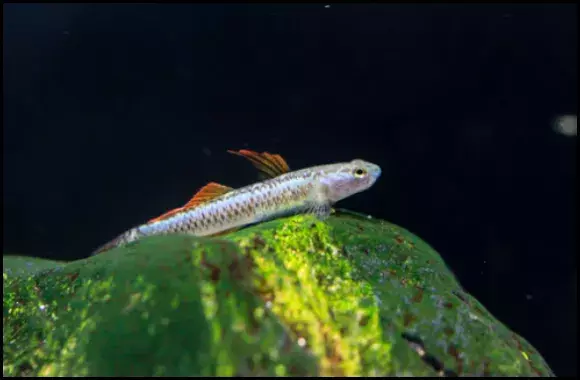
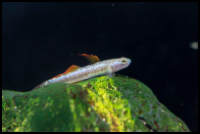
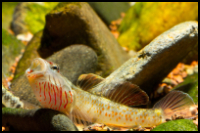
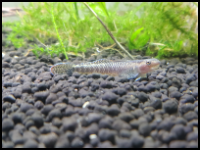
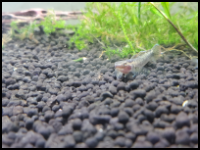
Quick Care Details (Table)
| Livestock Characteristics | Value |
|---|---|
| Care Level | Moderate |
| Temperament | Peaceful |
| Diet | Omnivore |
| Maximum Size | 2 Inches |
| Minimum Tank Size | 20 Gallons |
| Plant Safe | Yes |
| Temperature Range | 72-80F |
| PH Range | 6.5-7.5 |
| KH Range | 2-12 |
Species Specific Categories
Helpful Video
Care Details
Aquascape: So, when you're setting up a tank for these Freshwater Neon Gobies, think of recreating their natural environment. Add some rocks, driftwood, and aquatic plants to create a cozy space. These gobies love to hide and explore, so give them plenty of nooks and crannies to roam.
Substrate: For the substrate, go with fine sand. Freshwater Neon Gobies, especially Stiphodon, are into sifting through sand for food. It's like their version of treasure hunting. Keep the sand clean to keep your water quality in check.
Disease Prevention: Keeping your water quality in tip-top shape is your best defense against diseases. Regular water changes and monitoring the water conditions are crucial. If you're bringing in new fish, quarantine them first to avoid spreading diseases in your tank.
Filtration: Make sure you've got a solid filtration system in place. Freshwater Neon Gobies are all about clean water, so good filtration is a must. Gentle water flow works best since they come from calmer waters in the wild.
Lighting: You don't need anything too fancy in the lighting department. Moderate to low lighting is good enough. It's more about enhancing the look of your tank and showing off those beautiful gobies.
Water Flow: Speaking of water flow, these gobies like it gentle. Create spots in your tank with slower water movement so they can chill out without being swept away.
Hardiness: Stiphodon gobies are pretty tough cookies, but they don't like sudden changes in their environment. So, consistency is key. Keep their water conditions steady, especially the temperature, pH, and salinity if you're keeping a brackish setup.
Acclimation: When you're introducing new gobies, give them a gentle welcome. Gradual acclimation to your tank's water conditions is the way to go. It helps them ease into their new home without stress.
Expected Lifespan: With proper care, these gobies can hang around for 2 to 3 years in your tank. Give them a stable and comfy home, and they'll reward you with their presence for a good while.
Special Requirements: Some Stiphodon species thrive in brackish water, so know your goby's specific needs. They're into a varied diet, so offer them a buffet of food choices, especially tiny invertebrates.
Temperament and Behavior
Behavior: Picture these gobies as the lively explorers of your tank. They're always on the move, darting around, and checking out everything in their underwater world. Curious little fellas, they're not the shy type, and they'll happily interact with their fellow tank mates and their environment.
Breeding: Breeding Stiphodon gobies can be quite a show. They're able to breed in a safe aquarium normally with just one male and female. Having places to hide lots of food and a small cave would really help the process.
Aggression: In the world of fish, these gobies are considered pretty chill. They don't pick fights, especially not with their own kind. But during the breeding season, the guys might get a bit territorial, as love can make anyone a little protective.
Tankmates Compatibility: If you're looking for some good company for these gobies, think peaceful and small. They get along well with other fish that share their water preferences and don't hassle them. So, think about creating a harmonious community in your tank.
Activity Level: These gobies are like the life of the party in your aquarium. They're super active during the day, always on the go. Their lively behavior brings a lot of energy and fun to your tank.
Schooling or Shoaling Behavior: You can have multiple in a tank, but they are best on their own due to slight territorial levels especially if you have two males.
Plant Compatibility: Here's the good news – they're plant-friendly. They won't nibble on your aquatic greenery. In fact, having some live plants can give them extra hiding spots and create a more natural environment. Just choose plants that can handle their water conditions and the occasional digging in the substrate.
Diet and Nutrition
Dry Foods: Freshwater Neon Gobies, including the Stiphodon species, are usually open to eating dry foods like high-quality flakes and pellets. These foods are convenient for aquarium keepers and provide a balanced diet when formulated for small freshwater fish. They can be a good staple food source for your gobies.
Frozen Foods: While dry foods are commonly accepted, Freshwater Neon Gobies, including Stiphodon, can also enjoy the occasional treat of frozen foods. Offer them options like daphnia or bloodworms. Make sure to thaw the frozen foods before serving to make it easier for your gobies to gobble them up.
Live Foods: Freshwater Neon Gobies, particularly the Stiphodon species, are known for their preference for live foods. They thrive on tiny live invertebrates like copepods, small crustaceans, and aquatic insect larvae. Offering live foods can truly make their day and help mimic their natural diet.
Vegetables: These gobies are primarily carnivorous and not very interested in veggies. Their diet should focus on protein-based foods, so you won't find them munching on greens.
Algae: These little guys are natural grazers on algae and bio-film in your aquarium. They will constantly be attached to the glass and rocks in your aquarium looking for food to eat.
Feeding Schedule: To keep your Freshwater Neon Gobies, including Stiphodon, happy and healthy, it's recommended to feed them several small meals throughout the day. This reflects their natural feeding behavior, where they're constantly on the lookout for small prey. It also helps maintain water quality by preventing overfeeding.
Supplemental Foods: In addition to their primary diet of dry and live foods, you can include specialized goby pellets or flake foods designed for small freshwater fish as supplements. These products are crafted to provide the essential nutrients your gobies need for overall well-being.
Tank Parameters
Tank Size: For a small group of Stiphodon gobies, a tank size of about 10 to 20 gallons can be sufficient. However, a larger tank provides more room for them to explore and establish territories.
Tank Length and Measurements: When it comes to the tank's length and measurements, consider an aquarium that's at least 24 inches long. This gives them ample space to swim and explore the substrate.
Water Temperature: Stiphodon gobies thrive in slightly warmer waters. Keep the temperature in the range of 74°F to 82°F (23°C to 28°C) to mimic their natural habitat.
pH (Acidity/Alkalinity): Maintain a pH level of around 7.0 to 8.0 for these gobies. They are adaptable to a moderately alkaline environment but avoid extreme pH fluctuations.
KH (Carbonate Hardness): A carbonate hardness (KH) level of 6-10 dKH is suitable. This helps maintain pH stability and provides a buffer against rapid pH changes.
GH (General Hardness): Stiphodon gobies are comfortable with a general hardness (GH) range of 8-15 dGH, which aligns with their natural habitat's water conditions.
Hardiness: These gobies are generally hardy fish, but they do best when provided with stable water conditions. Avoid sudden changes in water parameters to ensure their well-being.
Nitrate (NO3) levels: Keep nitrate levels in check, ideally below 20 ppm (parts per million), by performing regular water changes and maintaining good filtration. Elevated nitrate levels can stress the fish and affect their health.
History, Popularity, History and Species Variety Details
The History, Popularity and Natural Habitat
History: So, these Freshwater Neon Gobies, specifically the Stiphodon bunch, have been hanging out in the rivers and streams of Southeast Asia for ages. They're like the local legends of those waters. They've only recently become big stars in the aquarium world, though. It's like they were hidden gems waiting to be discovered.
Popularity: These gobies have really made a name for themselves in the fish-keeping community, and it's not hard to see why. Their colors are like a living work of art, and their lively antics make them the life of the tank. Plus, their quirky breeding habits, with males guarding eggs in their mouths, have made them the talk of the town. It's like having a mini aquatic spectacle in your living room.
Natural Habitat: Picture them in their natural habitat – clear, fast-flowing streams and rivers in Southeast Asia. They're like the cool cats of the rocky riverbeds, blending in with the vibrant aquatic life. These places have slightly warm waters, usually around 74°F to 82°F (23°C to 28°C), and a slightly alkaline pH of 7.0 to 8.0. It's all about replicating that homey feeling in their aquarium setup to keep them happy and healthy.
In a nutshell, Stiphodon Neon Gobies have a long history in the streams of Southeast Asia and have become aquarium celebrities due to their stunning looks and quirky behaviors. Their natural habitat is like a lively, fast-flowing party, and bringing a slice of that into your tank is what it's all about.
Back to topVariations Of the Neon Goby Stiphodon Species
There are several variations or species within the Stiphodon genus, and they can display a range of colors and patterns. These variations are often influenced by the specific region in Southeast Asia where they are found. Some common species or variations of the Stiphodon Neon Goby include:
- Stiphodon atropurpureus: This variation often displays a vibrant purple coloration, making it particularly eye-catching.
- Stiphodon semoni: These gobies may have a combination of blue and yellow hues, creating a striking appearance.
- Stiphodon elegans: Known for their striking blue coloration, particularly in males, with some variations featuring yellow markings.
- Stiphodon anniae: This variation is recognized for its deep blue and yellow colors, creating a visually stunning goby.
- Stiphodon pelewensis: These gobies may showcase a combination of blue and yellow colors, with males often being more colorful than females.
Frequently Asked Questions
What is a Stiphodon Neon Goby, and what makes it unique?
A Stiphodon Neon Goby is a captivating and active freshwater fish known for its vibrant colors and energetic behavior. It's unique for its beautiful appearance and interesting behaviors, like breeding and exploring.
What size tank is suitable for Stiphodon Neon Gobies?
A tank size of at least 10 to 20 gallons is suitable for a small group of Stiphodon Neon Gobies. However, larger tanks provide more swimming and exploration space.
What are the ideal water parameters for Stiphodon Neon Gobies?
Stiphodon Gobies thrive in slightly warm water with a temperature range of 74°F to 82°F (23°C to 28°C). The recommended pH range is 7.0 to 8.0, with a carbonate hardness (KH) of 6-10 dKH and a general hardness (GH) of 8-15 dGH.
Are Stiphodon Neon Gobies hardy fish?
Yes, Stiphodon Neon Gobies are generally considered hardy, but they prefer stable water conditions. Avoid sudden changes in parameters to ensure their well-being.
What do Stiphodon Neon Gobies eat?
They are omnivorous and enjoy a diet that includes both small live invertebrates and high-quality flake or pellet foods. Offering a varied diet is best.
Can Stiphodon Neon Gobies be kept with other fish?
Stiphodon Neon Gobies are generally peaceful and can coexist with other small, non-aggressive fish species. Just ensure that their tank mates share similar water parameter requirements.
Do Stiphodon Neon Gobies prefer a specific tank setup?
They appreciate a tank with hiding spots like rocks and plants, as well as a sandy substrate for sifting through. Live plants can add to their habitat's aesthetics.
What is the expected lifespan of Stiphodon Neon Gobies?
With proper care, Stiphodon Neon Gobies can live for 2 to 3 years in an aquarium. Maintaining stable water conditions and a balanced diet contributes to their longevity.
Do Stiphodon Neon Gobies require special care or attention?
They are generally low-maintenance fish, but it's important to maintain water quality, offer a varied diet, and keep their environment stable. Avoid drastic changes in water parameters to keep them healthy and happy.
Will They Jump From An Aquarium?
Stiphodon Neon Gobies are generally not known to be jumpers. Unlike some fish species that tend to leap out of the water, Stiphodon gobies are typically well-behaved and remain within the confines of the aquarium. However, it's always a good practice to have a secure lid or cover on your aquarium to prevent any unexpected incidents. This precaution is essential for the safety of your fish and to ensure they stay in their aquatic home.

